What Is Post Clicks On Facebook
With a daily active user count of 1.9 billion users around the world, it goes without saying that Facebook has a big influence in our world. And if you've taken the time to set up an effective Facebook marketing strategy, then you should also take a look at your analytics. Tracking the most important Facebook metrics for your brand helps establish how successful you are in reaching your goals.
On a global level, Facebook users span the range of age and gender. As of July 2021, Facebook's largest user demographic is 18.8% male users aged 25-34 years and the next largest at 13.8% is male users aged 18-24 years. But as you can see from the graph, there are still plenty of others who could be potential brand followers.
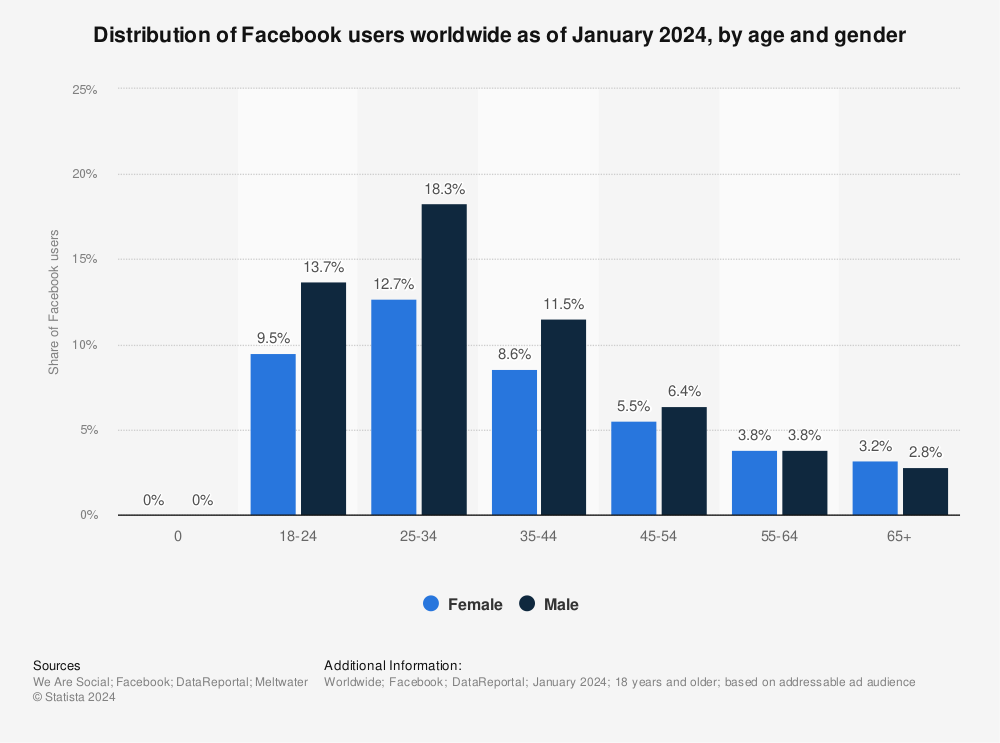
Why you should analyze your Facebook metrics
People use social media for a variety of reasons. A Statista report found that 65% of Facebook users used the network to view photos and 57% of them used it to share content with everyone.

How the general public uses Facebook versus how your target audience uses it are not always for the same reason. Knowing which of your posts receive the most engagement helps you tailor your content. When followers engage on your posts, is it because you posted at the best time or other metrics? Facebook metrics can also reveal if an ad campaign is successful, if your Facebook Lives are drawing high engagement, and how well that brand Group is performing.
16 Facebook metrics you should track
Below are 16 Facebook metrics you should track, grouped together by category.
- Facebook Page & Post metrics
- Facebook brand awareness metrics
- Facebook Group metrics
- Facebook video metrics
- Facebook ad metrics
Facebook metrics can be found in several ways. For the native route, Facebook offers Insights, found in your Business Manager. Creator Studio, also found in Business Manager, provides filterable metrics across multiple Pages. However, Sprout Social offers reports that you can easily review without doing your own math.
Facebook Page & Post metrics
This section covers the metrics that are most commonly associated with how your posts or Page perform.
1. Engagement
Engagement is the general catchall term for everything you can do as a user with a Page's post and profile page. This includes but is not limited to all the reactions, link clicks, shares, comments, clicks to the profile and more.
Why you should track engagement: Engagement tells you how your post resonates with your audience. The more a post is interacted with, the more likely it shows up in your fans' Newsfeed. Looking at the overall engagement numbers and the breakdowns per type of engagement tells you how people are reacting to your posts.
Where to find it
In Sprout, engagement analytics are part of the Facebook Pages Report. Each type is color-coded and is broken down for you to easily review. You can also access the Post Performance Report which details all the engagements that happened with every post.
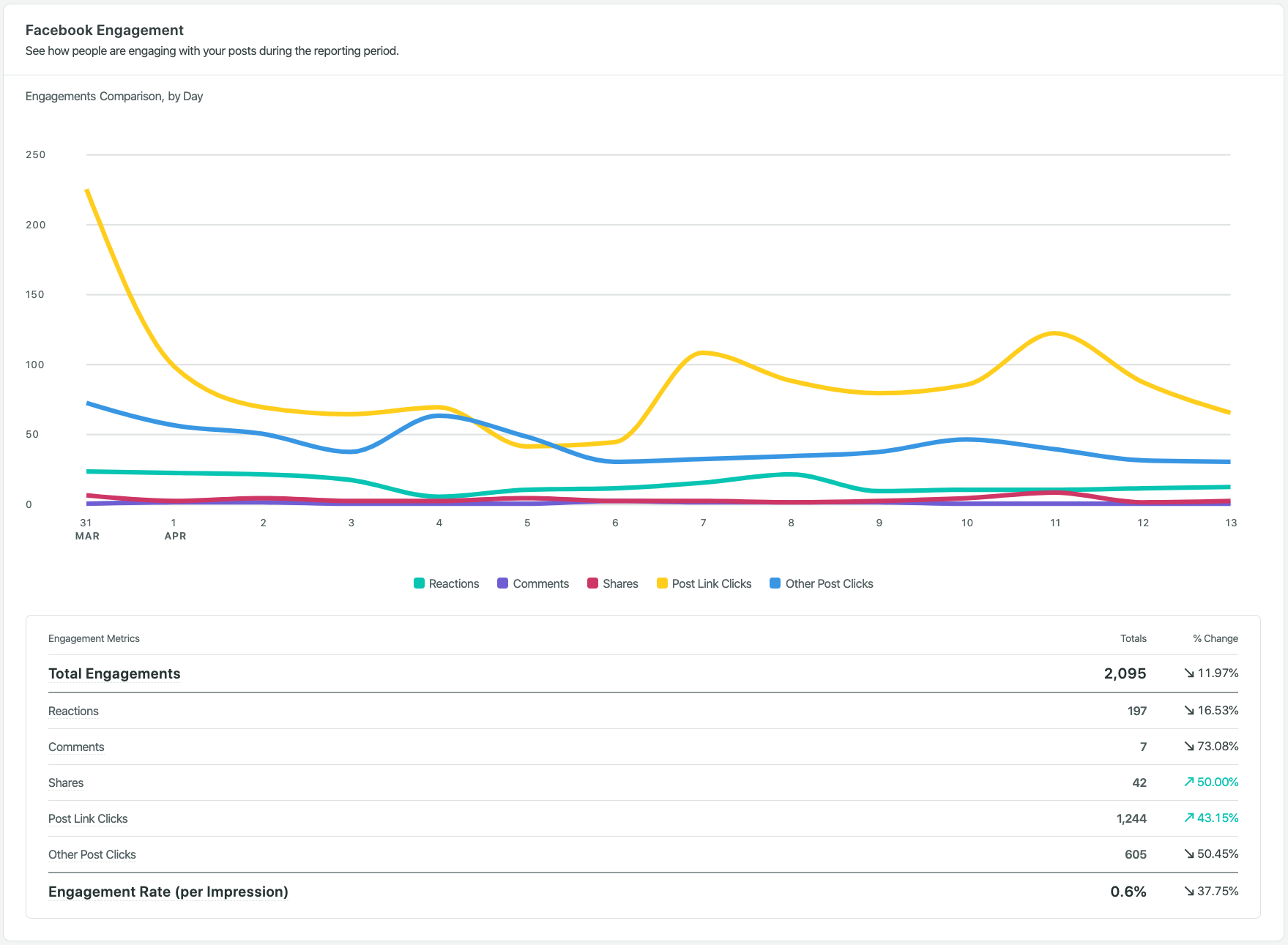
In Facebook Insights, the metrics can be found in the Content tab. And in Creator Studio, overall engagement numbers are found in the Insights tab while post-level ones are in the Published tab.

2. Engagement rate
Engagement rate is a calculated metric where you take the total number of engagements and divide by the total reach number. Multiply that number by 100% to get the engagement rate of your post.
Why you should track engagement rate: Your engagement rate, whether high or low, can tell you a lot about your posts. An engagement rate per impression shows you how interesting your post was to the number of times it was shown. For example, a high engagement number with a very high impression number tells a different story from a high engagement number with a low impression number. Factors include what time you post on Facebook, the use of images or videos, and much more.
Where to find it
In Sprout, the engagement rate per impression is automatically calculated in the Facebook Page Report.
Did you suddenly realize that your engagement rate isn't as high as you'd like it to be? Review our tips on how to increase your Facebook post engagement.
3. Reach
Facebook makes a distinction between reach and impressions. At the post level, reach is the potential unique viewers a post could have. This includes both organic and paid reach.
Why you should track reach: Reach gives you a clear picture of how many unique people saw your post or Page. For example, you could have 10 impressions but only one reach on a post. So you can assume this person is very interested in your brand. In conjunction with other metrics like impressions, reach tells you if your posts or Page are finding the right people.
Where to find it:
Reach is found in several locations in Sprout. The Facebook Page Report provides an average daily reach per page, which is automatically calculated. Additionally, the Post Performance Report provides both average reach and average potential reach per post as a part of Premium Analytics.
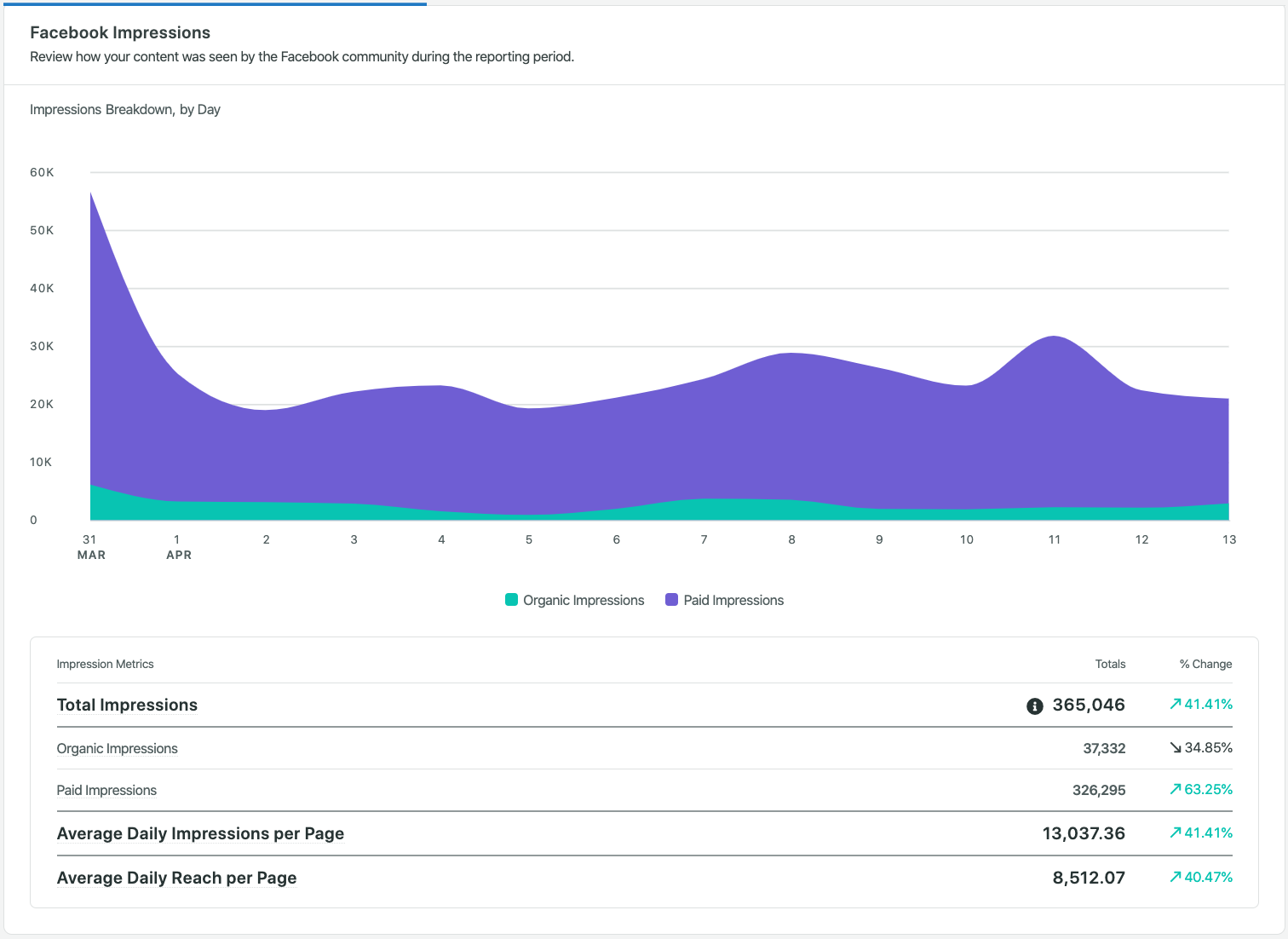
In Facebook Creator Studio, reach is found in the Insights tab and Published tab.

If you're looking to boost this metric, we've outlined six different tactics are explored to help you increase your Facebook reach.
4. Impressions
Either equal to or higher than the reach number, impressions are how many times a post shows up in someone's timeline.
Why you should track impressions: The more times someone sees your post, the more interesting it might be to them. Repeat impressions means that someone either saw it multiple times in their feed or, even better, navigated back to find the post or your Page again.
Where to find it
In Sprout, Page impressions are at the top of the Facebook Page Report. You can find post-level impression metrics in the Post Performance Report.
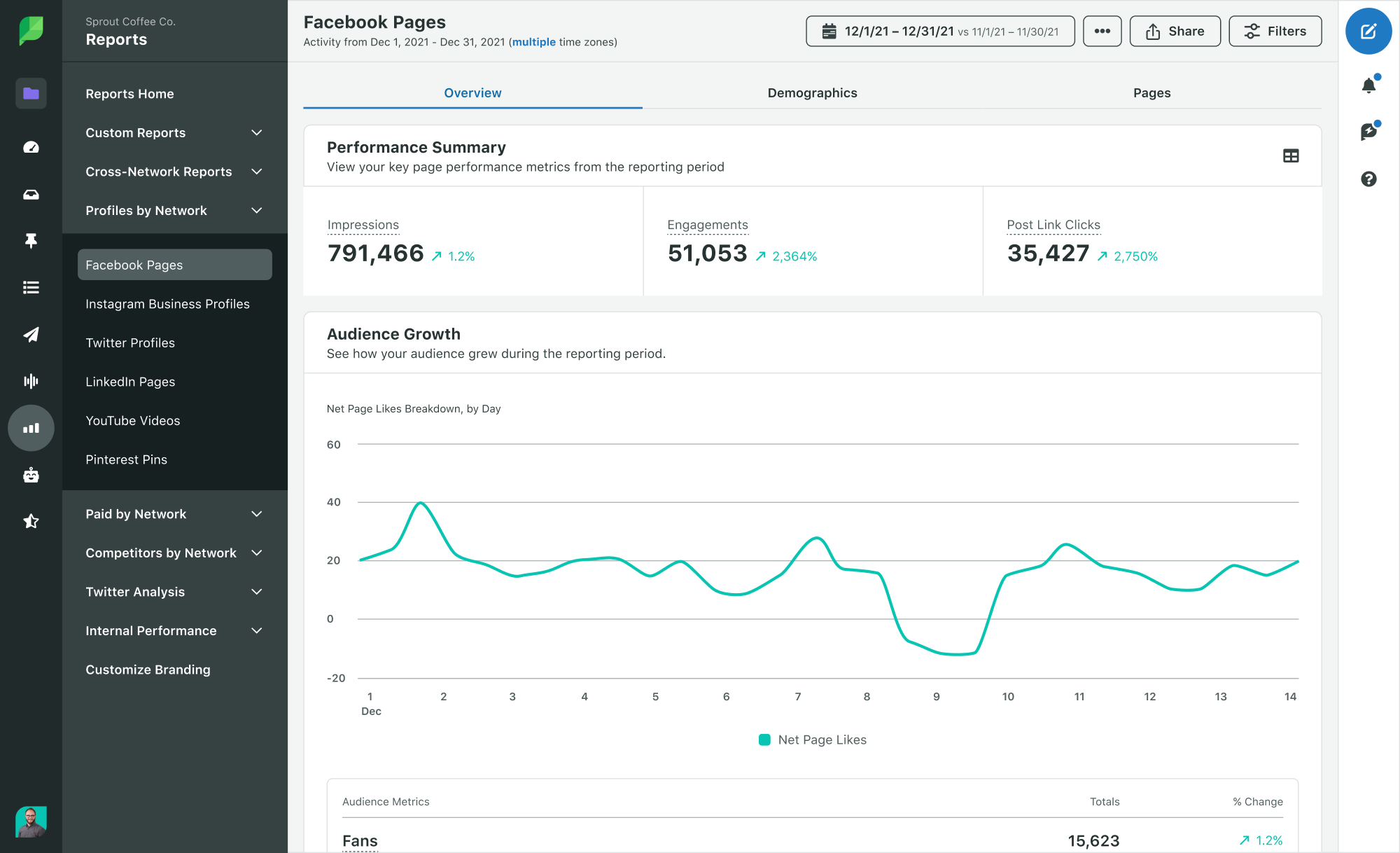
In Facebook Creator Studio, per-post impression metrics are found in the Published tab.

5. Page Likes & followers
As one of the very first metrics for Facebook Pages, Likes and follower numbers indicate how willing someone is to stay in touch with your brand. They might like a post or two but if they hit the Like or Follow button? They want to know what you're up to.
Why you should track Page likes and followers: This metric tells you how interested someone is in your company. Likes and followers should not be standalone metrics, though. If you compare your impressions metric with the Likes metric, you'll understand how far your posts are really going.
Where to find it
You can find these metrics in the Pages tab of the Facebook Pages Report.
In Facebook Insights, likes are in the overview tab and audience section. And in Creator Studio, follower details are in the Insights' tab and Audience section.
Facebook brand awareness metrics
This section covers how people find your brand, what demographic groups they're part of and how much space you're taking up in the digital sphere.
6. Facebook referral traffic
This metric describes the number of times someone clicked from your Facebook Page to get to your website. If you publish a lot of blog posts or product links on Facebook, this is a good metric to monitor.
Why you should track Facebook referral traffic: Having a significant referral traffic number here tells you if your Facebook posts are effective. This number is excellent for general traffic tracking but also for ad campaigns where you create a landing page on your website.
Where to find it
In Sprout, integrate with your Google Analytics and find the metrics in the Google Analytics Report.

Alternatively, you can head to Google Analytics itself and find it in the network referral section.

7. Follower demographics
Demographics metrics break down your audience base so you can tailor your content better to them. How much money does your average follower make? Where do they live? What age range are they?
Why you should track Facebook follower demographics: Knowing who makes up your audience helps you tailor your content better. Your audience demographic is an important component of building your brand's social media personas.
Where to find it
In Sprout, the Facebook Page Report has a Demographics tab that breaks your audience down into age, gender, country and city.
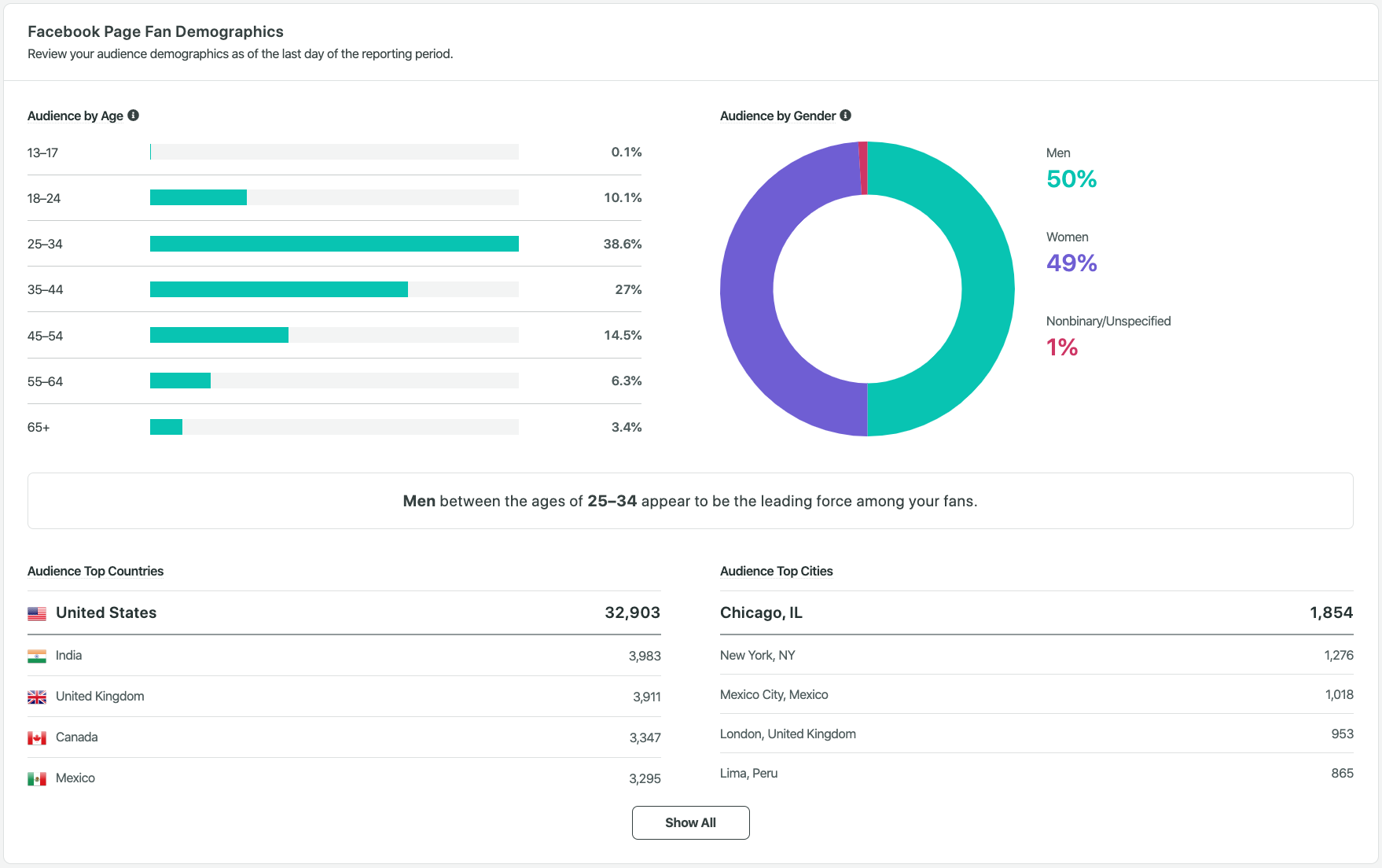
In Facebook Insights, the Audience tab provides some demographics and Creator Studio's Insights > Audience section adds on a few more demographics.

8. Share of voice
Share of voice is usually part of a competitive analysis or paid advertising campaign. It indicates how much of the online sphere your brand is taking part in.
Why you should track Facebook share of voice: Within your industry, you have competitors that also take up a similar audience and social space. The more one is talked about, the greater the share of voice is.
Where to find it
Calculate share of voice on your own with the formula:
Share of voice = Your brand metrics / Total market metrics
Or, use Sprout's social listening feature to help you track your share of voice. Input the keywords and topics you want to track and then check in with the results later on. Listening Topic Insights are filterable to a per-network level, so you can understand how your share of voice compares between Facebook and Twitter.
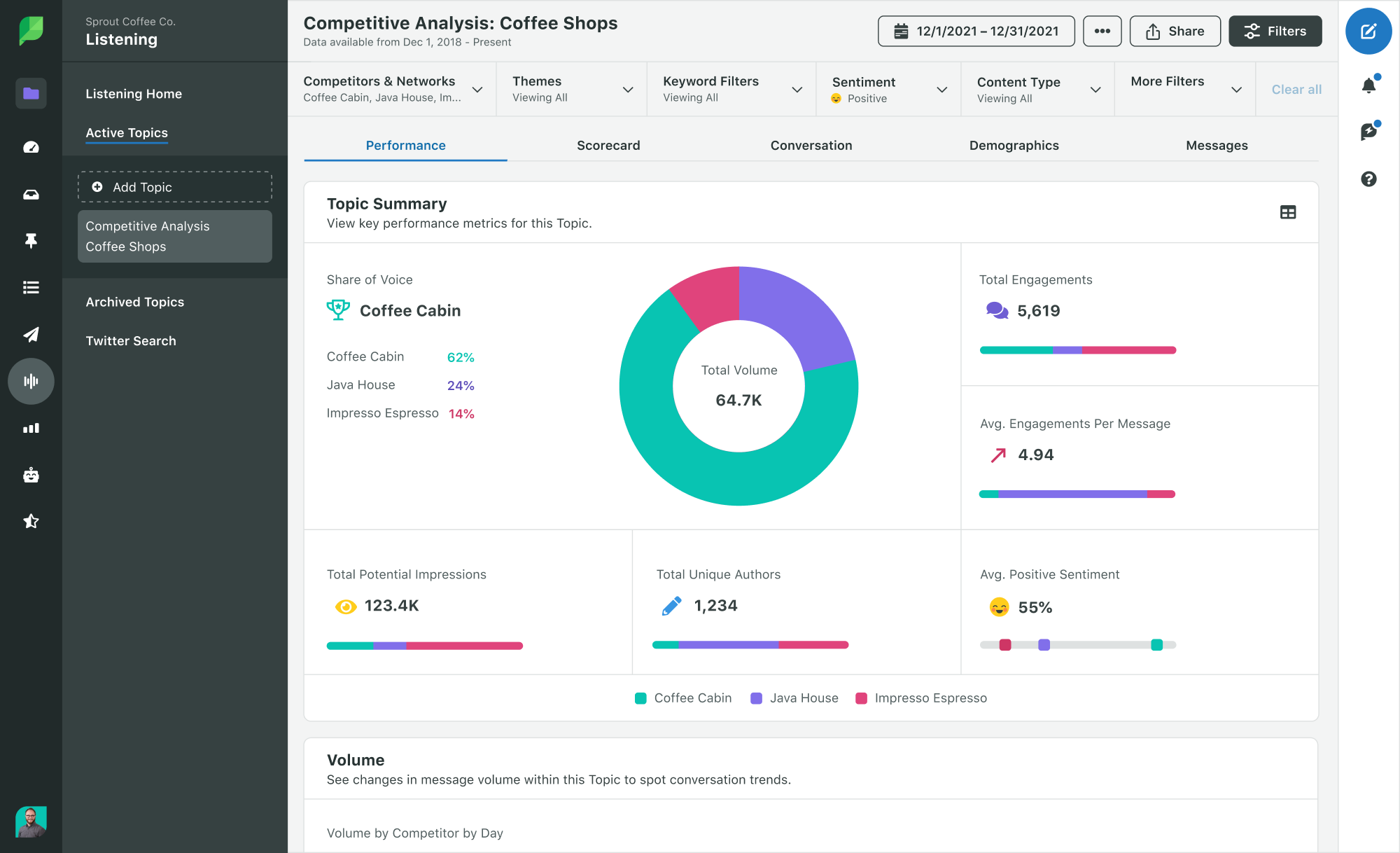
Facebook Group analytics
This section focuses on analytics that are specific to Facebook Groups. You'll be able to find the metrics if you are logged into the Group as an admin. Group Insights are available for Groups that are larger than 50 members.
9. Top contributors
Top contributors tell you who is most engaged inside your Group. These individuals are likely your biggest brand advocates who enjoy your content
Why you should track Facebook Group top contributors: Use this metric to know who you can rely on to drive conversations. Don't forget to thank them for their involvement and consider them as part of a pool to choose from if you need more moderators.
10. Engagement
This metric gives you the days and times your members are most active, as well as posts, comments and reactions counts.
Why you should track Facebook Group engagement: From this metric, you can determine when the best time to post is and how your members are engaging with posts.
11. Growth
Growth in Facebook Groups shows how many new members and active members you have within a period of time.
Why you should track Facebook Group growth: You want to grow your brand community and monitor how quickly it's growing. Building an engaged Group will indicate how well you're engaging your audience. Not as much growth as you want? You'll need to focus on additional ways to promote your Group.
Facebook video analytics
There are several Facebook video metrics to track, but we're highlighting just two of them. Video metrics are found at a per-video level in Facebook Creator Studio's Published tab. Clicking into each video provides additional metrics.

Sprout's Facebook Page Report also provides metrics in video performance, broken down into both organic and paid results.
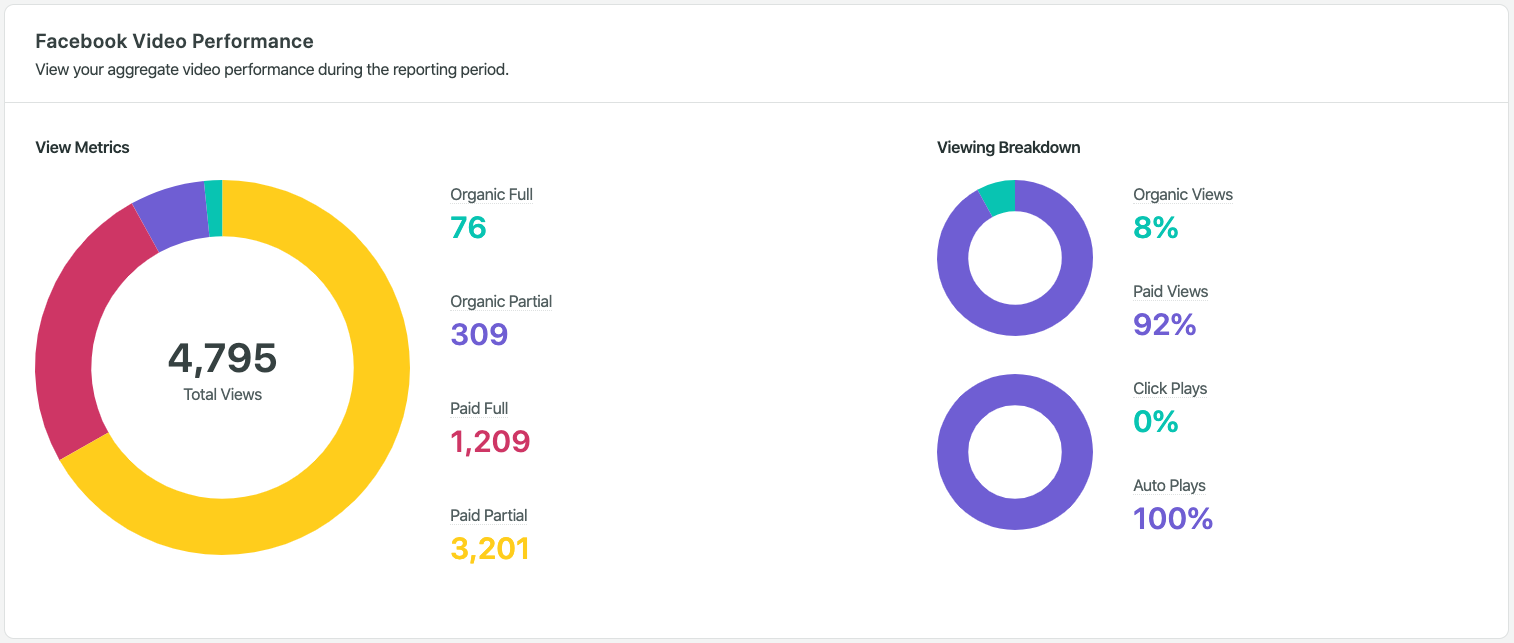
12. Audience retention
Audience retention is how long someone watched over the duration of the video.
Why you should track Facebook video audience retention: This number tells you how long viewers watch your videos. This Facebook metric may tell you how interesting a video is or if it is perhaps too long. It also guides your video marketing strategy. So if your videos are five minutes long and most are watching only five seconds, then video length is something to be worked on.
13. Video engagement
Similar to post engagement, the video engagement metric is specific to the Facebook videos you post. For videos, engagements are broken down into reactions, shares and comments.
Why you should track Facebook video engagement: The specific reactions tell you what your viewers are feeling when watching your videos and if they match your expectations.
Facebook ad metrics
Specific to the ad campaigns you run on Facebook, these are the most important metrics to watch to make sure your ads are on track. Because there are so many ways to run a campaign, it's best to go beyond these three metrics. For some campaigns, click-through rates (CTR) might not be as important as cost per impression (CPM).
Sprout's Paid Performance Report features analytics from your Facebook campaigns. Having this data on hand makes it easy for you to evaluate and adjust campaigns based on the Facebook metrics most important to your goals.

Your Facebook campaigns can be set and evaluated within Facebook Ads Manager. In addition to graphical insights that are provided with each campaign, there are also a multitude of metrics you can look at for each campaign, including engagement, people reached and budget.

Thinking you need a little more oomph to your ads? Explore the guide on creating your own Facebook advertising strategy. Or, if you're second-guessing your current ads, check out some strategies on how to optimize your ad ROI.
14. CTR
Click-through rate (CTR) is the number clicks on your ad divided by the number of times it has been shown. This is best examined when you want someone to take action on the ad. In some cases, such as those that are aiming for a high impressions count, CTR does not matter as much as CPM would.
15. CPC & CPM
Cost per click (CPC) is a paid advertising term where an advertiser pays a cost to a publisher for every click on an ad. If your campaign is set to charge for clicks (users have to click on an ad), then the CPC will be your metric. The average is $1.72 CPC. Cost Per Mille (CPM) is the cost per 1000 impressions. This is most often measured for brand awareness.

16. CPA
For campaigns with specific actions, like an app install, cost per action (CPA) is measured per action. The user will need to click the button for you to be charged.
Start tracking your Facebook metrics today
Tracking metrics is a vital part of any social media strategy. Facebook, as one of the largest social networks, has a multitude of metrics you can track. This guide lists the top 16 Facebook metrics and depending on your own strategy, your brand might add more to the list.
Instead of manually calculating your Facebook metrics in a spreadsheet, sign up for a free Sprout demo to explore all the advantages that Sprout analytics can bring to you.
What Is Post Clicks On Facebook
Source: https://sproutsocial.com/insights/facebook-metrics/
Posted by: martincongs1974.blogspot.com

0 Response to "What Is Post Clicks On Facebook"
Post a Comment